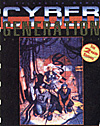 R. Talsorian Games
R. Talsorian Games
$21.95/248 pages
The first thing that I noticed about CyberGeneration was not the flashy graphics (which are very impressive) or the dynamic layout (which is also eye-catching). No, the thing that impressed me most with the game was the way that it teaches you how to play it. From the very beginning, the book treats you as if you are in the game, a participant in the world. It's a flash forward from R. Talsorian's famous Cyberpunk RPG, in a world where the cyherpunks have sold out. You play the children of the old 'punkers, trying to find your own identity in a world of flash style and no substance. The corporations have really got a hold of everything now (just wait till you see what Arasaka looks like twenty years down the road!) and they've corralled everyone into nice, neat little corporate blocks. The outside world is a total mess and nature has been exploited to the brink of extinction. As the younger generation, you of course rebel against everything your parents fought for. The only problem is, you aren't even old enough to shave.
Cybergeneration takes a very different look at the cyberpunk genre (as I read it, I was reminded of a book I read in grammar school called The Girl Who Owned A City, which should be required reading for this or any other dark future RPG), a perspective that is from the children of the age.
You begin the book with an introduction from an NPC who speaks to you throughout the texts. You go through the book listening to his instruction as he teaches you about the world, character creation and game mechanics. There's even a "datapad" for character creation. All the information you need is listed on one page formatted to look like a hand-held datapad. It's incredibly useful and builds the atmosphere even more. This is one of the most original and effective approaches I've ever seen to teaching a player and game master how to play your game (although Mr. Pondsmith did take a very similar approach in his fabulous game Castle Falkenstein, which is also worth a look-see).
Anyone who has played Cyberpunk before will recognize the system employed. It's a simple d10 difficulty number system, but there's a bit of a twist. You see, as a twelve year old, you aren't as good at sneaking about as a professional. That's why he's got a Stealth skill and you've got a Blend skill. Your skills only count at half their value when you're using them against adults. You've got to spend a lot of XP's to get your skills up to the "grump" level. It's just another example of how well R. Talsorian has considered the fact that these are kids in a grown-up world.
The kids do have one advantage, however. A virus has heen spreading across the glohe, killing some and... changing others. The virus changes the kids' genes, giving them powers heyond reason. For some, their skin turns to steel, for others, they gain a limited degree of control over electricity. Many just die painfully, but for those who gain these strange powers, the possibilities are limitless. The corporations are very aware of these mutations, however, and are on the lookout for the "cyber-evolved."
Dodging corporation bloodhounds, sabotaging executive bathrooms and disappearing into tight places where grown-ups can't go: that's what a Cybergeneratwn game is all ahout. Never give up, never sell out and keep the Revolution alive!
More Reviews
-
CyberGeneration RPG
Everway RPG
Kult RPG
Metropolos Sourcebook for Kult
Mekton Zeta Anime RPG
Mekton Zeta Plus: Advanced Technical Manual
Gangland CCG
Conspiracy X RPG
Mission Critical RPG
RPG Tools VLO computer utility
Fantasy General computer game
Terra Nova computer game
Back to Shadis #25 Table of Contents
Back to Shadis List of Issues
Back to MagWeb Master List of Magazines
© Copyright 1996 by Alderac Entertainment Group
This article appears in MagWeb (Magazine Web) on the Internet World Wide Web.
Other military history articles and gaming articles are available at http://www.magweb.com